I’m always looking for smart and creative ways to make a space feel bigger and more open.
One of my favorite tricks is to use curtains strategically to give the illusion of a larger room.
The right window treatments can really transform a small, cramped area into a light, airy oasis.
Today I will explain each concept in depth, so you can understand the interior design principles behind them.
Nowadays small living spaces become more common, it’s essential to know how to maximize every inch.
With some clever curtain styling, you can fool the eye into seeing a much grander space.
✨Click to Get My 101 FREE Designer Room Ideas
Extend Curtain Rods Past the Window Frame
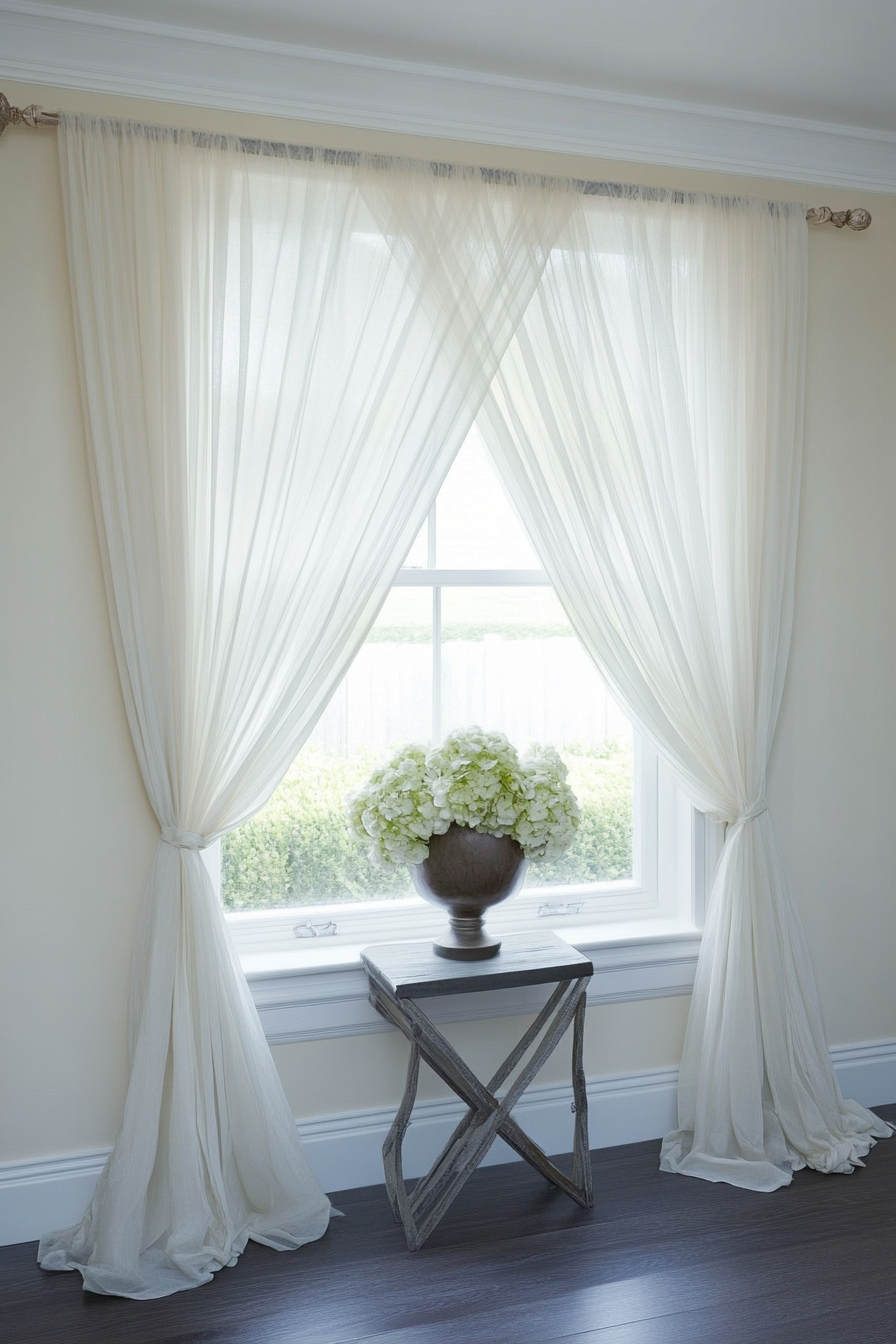
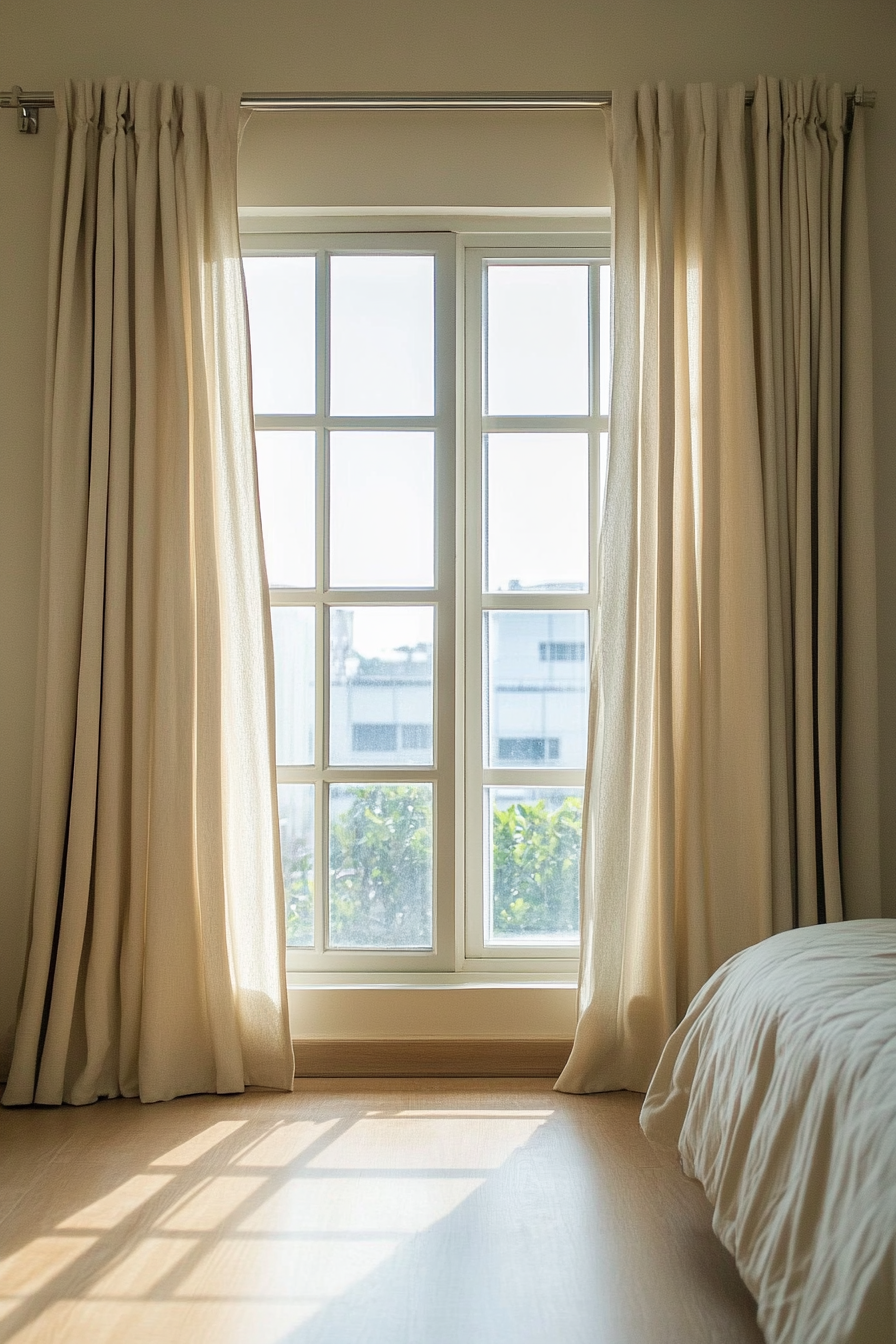
The first trick is one of my absolute favorites because it’s so simple, yet makes a major impact.
All you need to do is extend your curtain rod a few inches past the window frame on each side.
This makes the window appear wider than it really is.
I recommend going 4-6 inches beyond the frame.
Measure the width of your window first to find the right overhang for the curtain rod.
Don’t go too far beyond the frame or the rod will look comically wide.
A subtle extension is all you need to achieve the optical illusion.
This trick works especially well if you have a wide curtain panel that waterfalls over the edges of the rod.
The cascading fabric on each side makes the window seem even wider.
I’ll often use 140-inch panels on a 120-inch wide window to get that billowing look.
When designing a space, I’ll select curtain rods specifically for extending past the window framing.
I prefer simple metal rods no thicker than 3/4 inch.
Thin rods disappear better for this technique.
Make sure to get a rod long enough to accommodate the extra length.
Don’t be afraid to play around with different overhangs to see what looks best.
An extra 4 inches can sometimes feel too subtle, while 8 inches may look overpowering.
Find the sweet spot that makes your window feel expansive without going overboard.
Extending curtain rods is one of the easiest ways to trick the eye into seeing a larger window.
All it takes is a slight rod overhang and wide curtain panels.
Give it a try – I think you’ll be amazed by the difference!
Hang Curtains High and Wide
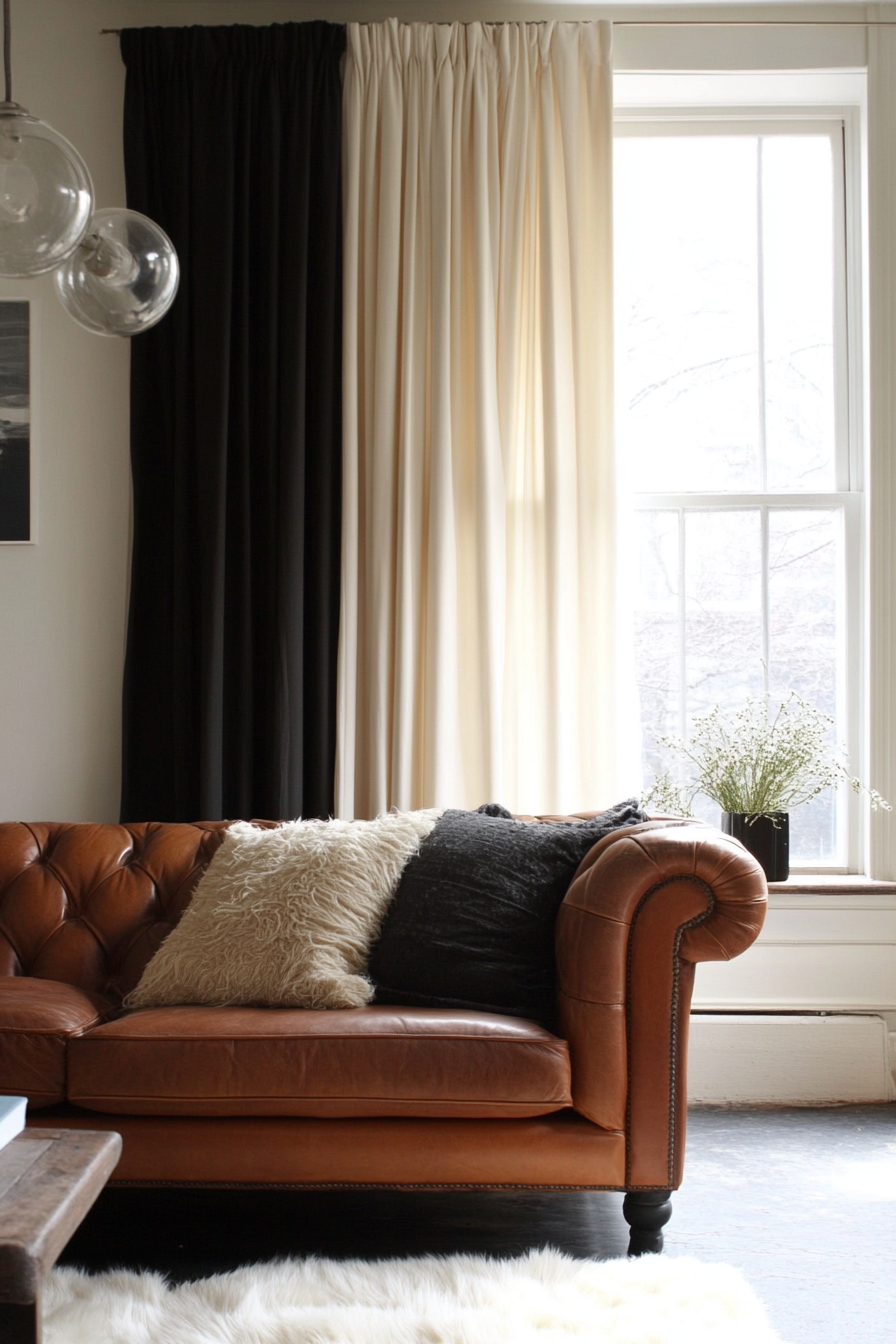
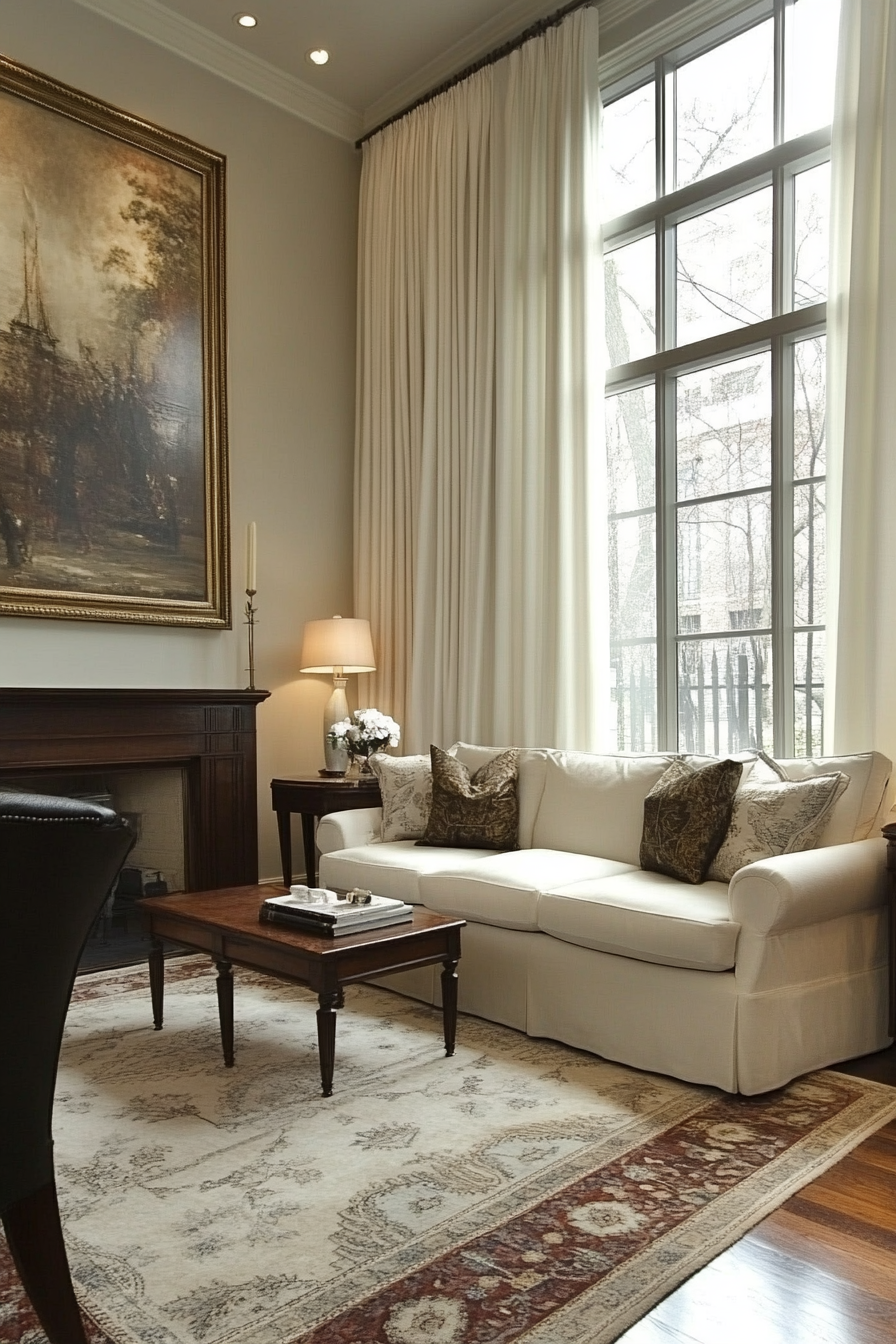
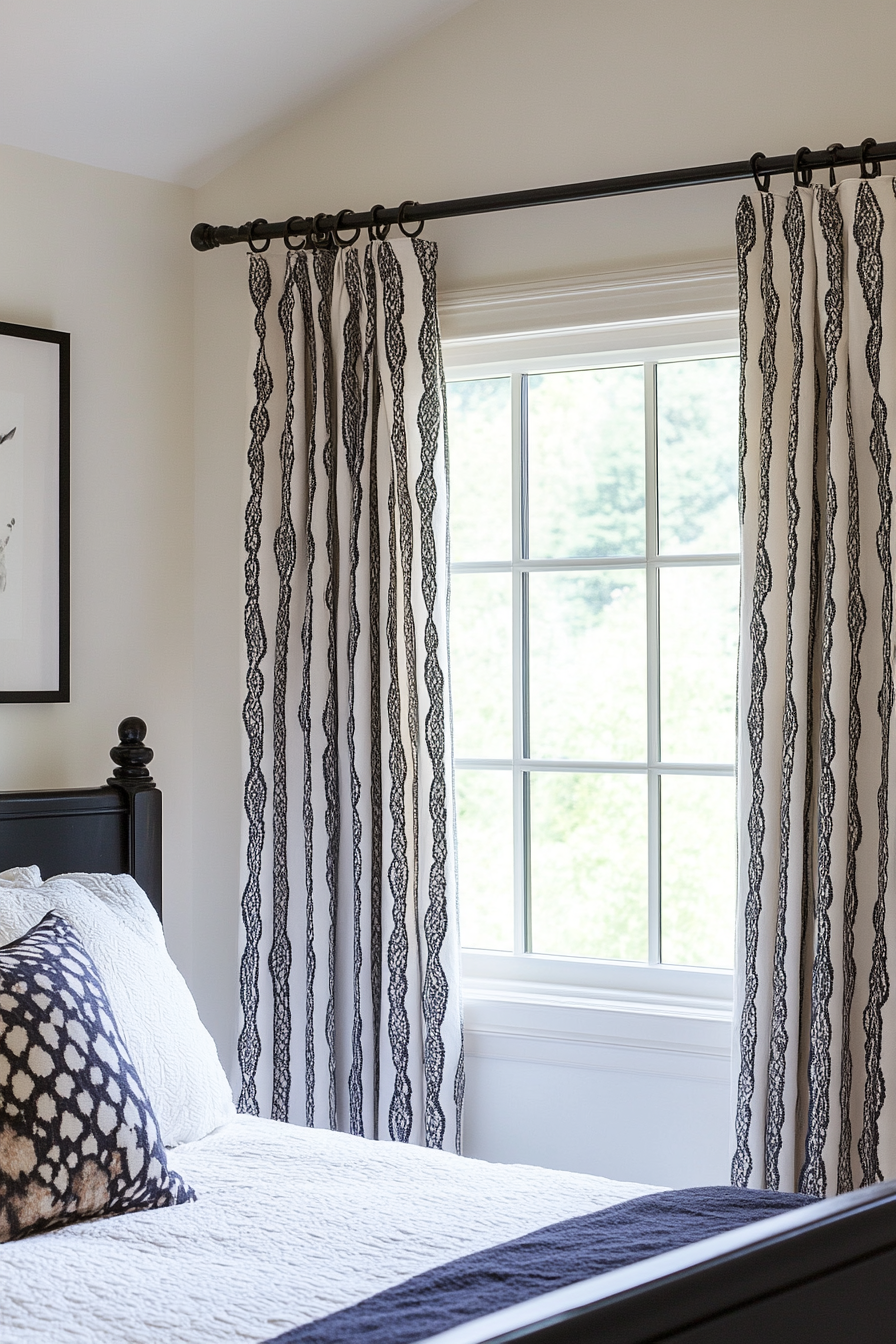
In addition to extending curtain rods, also consider mounting them higher and wider than the window frame.
Hanging curtains above the molding makes your windows appear taller.
And a rod that’s wider than the window adds a similar expanding effect.
I typically mount rods 6-12 inches above the window frame.
Any higher starts to look awkward.
For the rod width, go 6-12 inches beyond the window sides.
This trick builds on the extending rod concept, but takes it a step further.
You get the illusion of a larger window both vertically and horizontally.
High and wide mounting gives a nice squared off look to accentuate the window size.
When going wider than the window itself, make sure the walls around it are fairly simple.
Busy wallpaper or intense colors can compete visually and diminish the widening effect.
Neutral walls allow the curtain to take focus as the main architectural feature.
Also, be sure the extended rod doesn’t interfere with window operation or furnishings.
Test that shades and blinds still work smoothly and size furnishings accordingly.
A little planning goes a long way!
I use this trick on small bathroom windows a lot.
Going high and wide makes the window look like a grand feature, even if it’s just 2 feet wide.
It adds style and expansiveness in one easy step.
Hanging curtains high and wide requires some precise measuring and mounting.
But it’s a great option if you want to super-size a window for maximum visual impact.
Give those windows a growth spurt!
Use Floor-to-Ceiling Curtain Panels
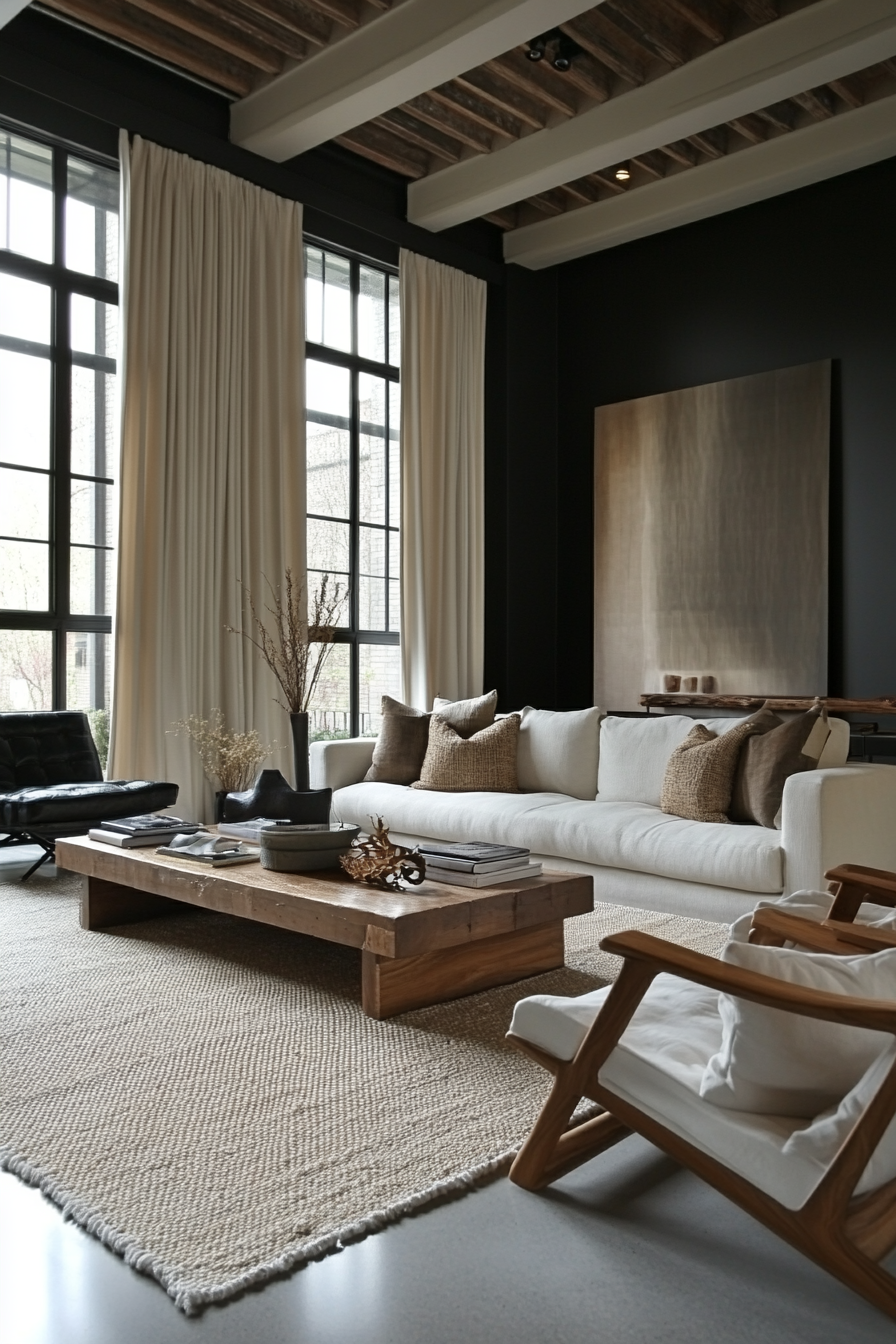
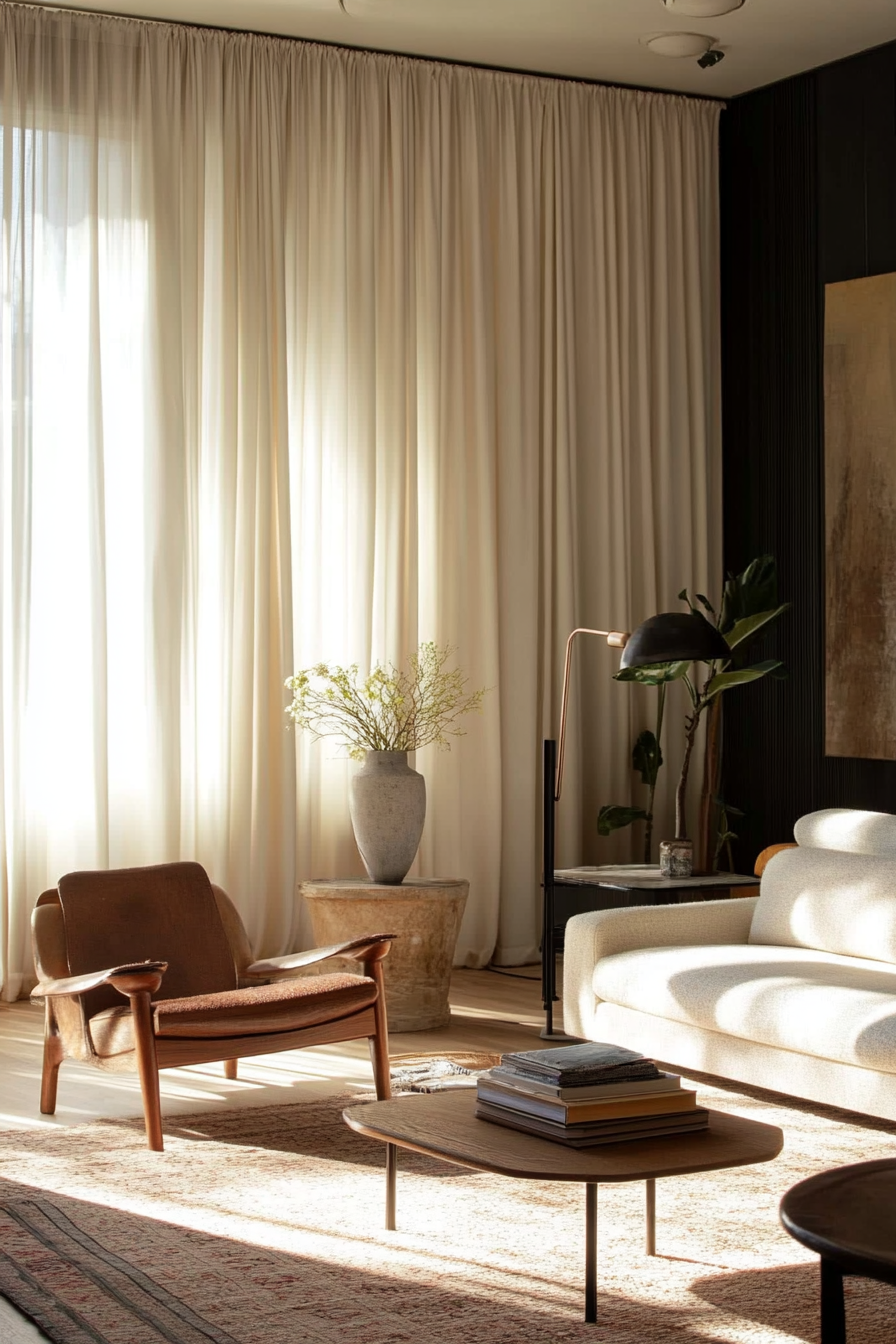
For a real wow factor, install floor-to-ceiling curtain panels that span from just under the ceiling to just above the floor.
This makes windows appear hugely tall, opening up the whole wall.
It’s one of the most luxurious treatments you can do.
I love using ceiling-height curtains in living rooms and bedrooms.
The ultra-tall panels make quite a statement.
They can make an average 8-foot window feel two stories high!
Make sure to have a sturdy curtain rod securely mounted to handle the long panels.
I prefer bracketed traverse rods or tension rods.
Have the rod installed just under the ceiling trim to maximize height.
And leave just an inch or two of space at the bottom off the floor.
When selecting panels, pay attention to the fabric length and Fullness.
To avoid sagging, choose high-quality, lined curtains in lengths to match your ceiling height.
And look for “full length” styles with at least 100% fullness so the pleats stack nicely.
It takes some work to install floor-length curtains, but the payoff is huge.
You transform simple windows into focal points that define the whole room.
I’ve seen cramped spaces opened up just by adding super tall curtain panels.
Now, full floor-length curtains do subtract visual space at floor level because they cover the wall at the bottom.
But the expansiveness they add vertically outweighs the little bit of floor space concealed.
So don’t be afraid to try ceiling-height curtains if you want serious vertical proportions.
Just be prepared for high-end custom panels and proper installation.
Then get ready to wow!
Hang Curtains Wide, But Use Sheer Panels
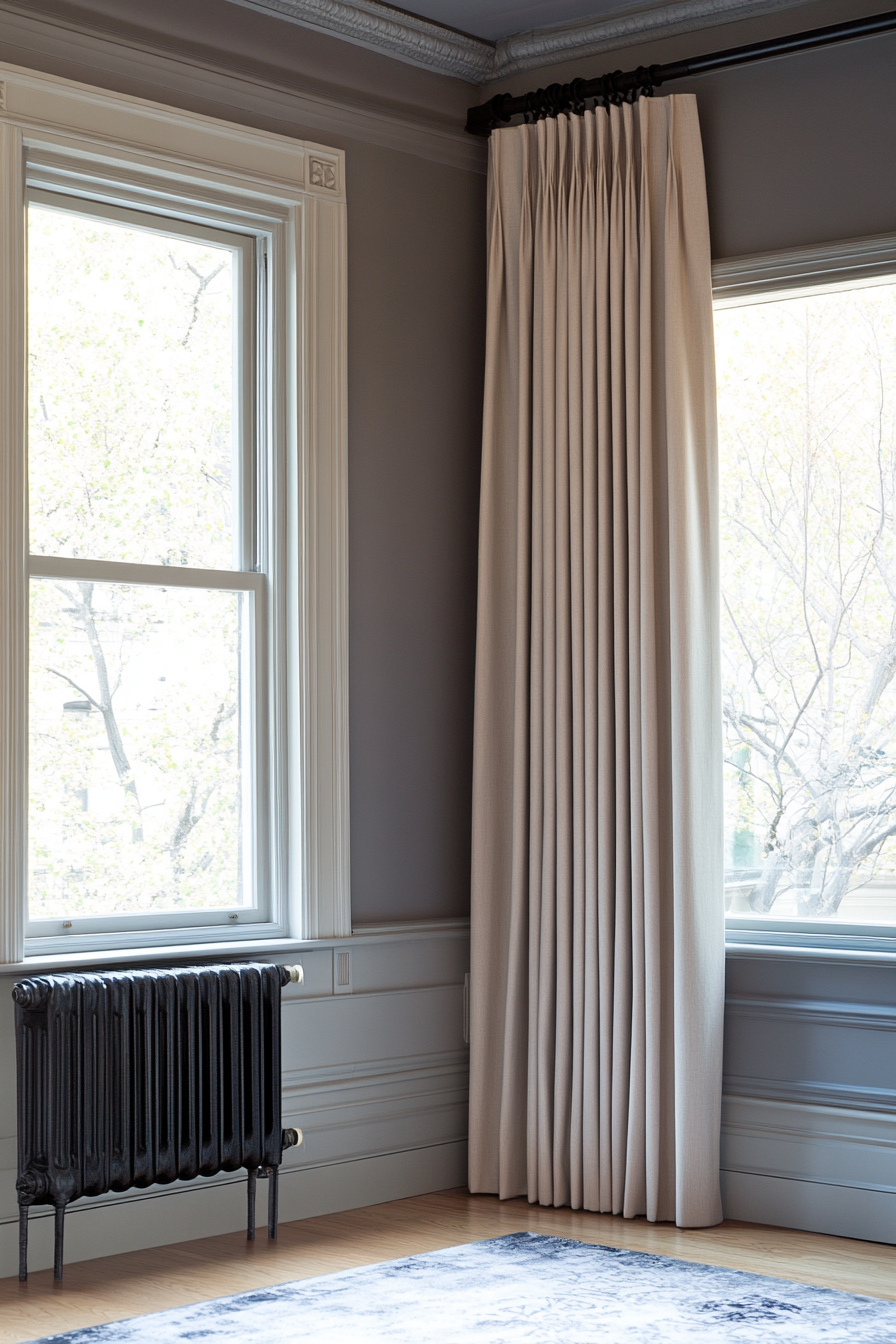
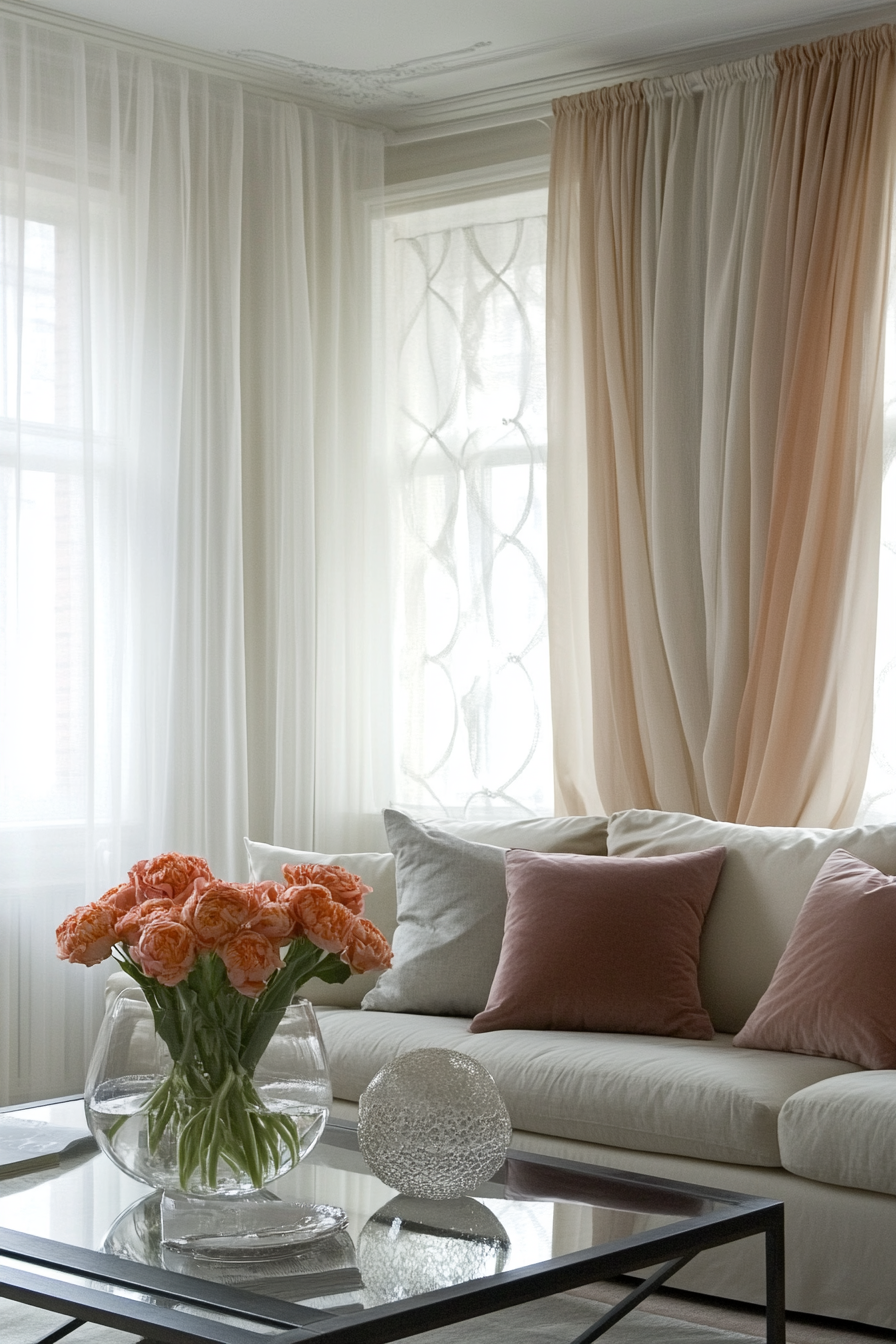
If you like the wide curtain look but want a lighter feel, use sheer panels instead of heavy fabrics.
Wide sheer curtains maintain an airy vibe while still expanding the window horizontally.
Sheers are made from lightweight see-through materials like voile, organdy or gauze.
They let in natural light while softening views.
Sheers create an open, breezy effect even in small spaces.
Wider window dimensions visually widen a room.
But solid wide curtains can sometimes look imposing and darken the space.
That’s where sheers save the day!
I recommend using light-filtering sheer panels so the fabric isn’t totally transparent.
These provide just enough privacy while maintaining that airier look.
Or layer sheers behind normal curtains to get the best of both worlds.
Close the solid curtains at night for privacy and insulation.
Then open them in the day to reveal the expanded window with breezy sheers.
When buying sheer curtains, pay attention to the fullness and allow for extra width.
you’ll want at least an 80% fullness factor.
And make sure the panels are wider than your window to create the optical enlargement.
Wide sheers work in any room where you want to keep things lightweight and bright.
The transparent fabrics prevent a closed-in feeling even when drawn closed.
Give them a try if you like the wider curtain look without the heaviness.
✨Click to Get My 101 FREE Designer Room Ideas
Add Curtains to Windows Without Them
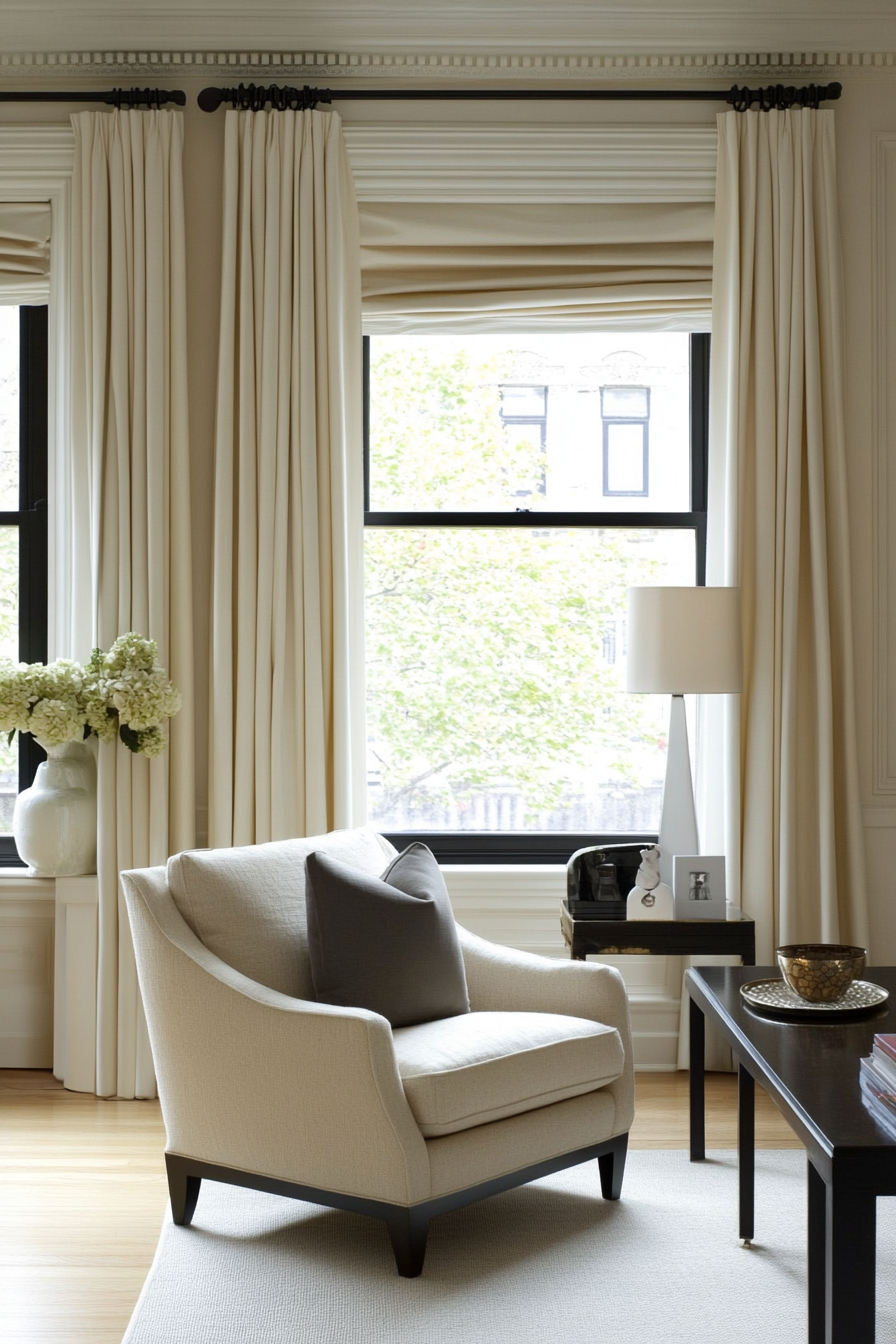
This next idea may seem counterintuitive, but hear me out.
Sometimes adding curtains or blinds to windows that didn’t have treatments before can expand the room’s proportions.
If a room only has bare windows, it can look disjointed and unfinished.
The walls, windows and rest of the space don’t tie together in a cohesive way.
Adding proper window treatments helps integrate the windows into the overall design.
Well-dressed windows also become an accent feature that draws the eye.
They add height, texture and visual interest to the wall.
Window treatments make the windows seem more intentional and noticeable.
Curtains in a complementary color and material unify the walls and windows into one harmonious space.
The windows blend right into the room scheme.
Suddenly the space looks more pulled together and expansive.
When installing new curtains or blinds, make sure they work with the room’s decor.
If you have warm grey walls, avoid stark white curtains (unless going for a contrast look).
For a cohesive feel, select a similar neutral tone.
You can also echo other room elements like introducing curtain trims that match chair fabric.
Tying it all together makes the whole space feel bigger.
Sometimes the missing design piece is window treatments.
Don’t underestimate their power to make a room feel finished and expanded.
Adding the right curtains or shades completes the look.
Flank Windows with Drapes
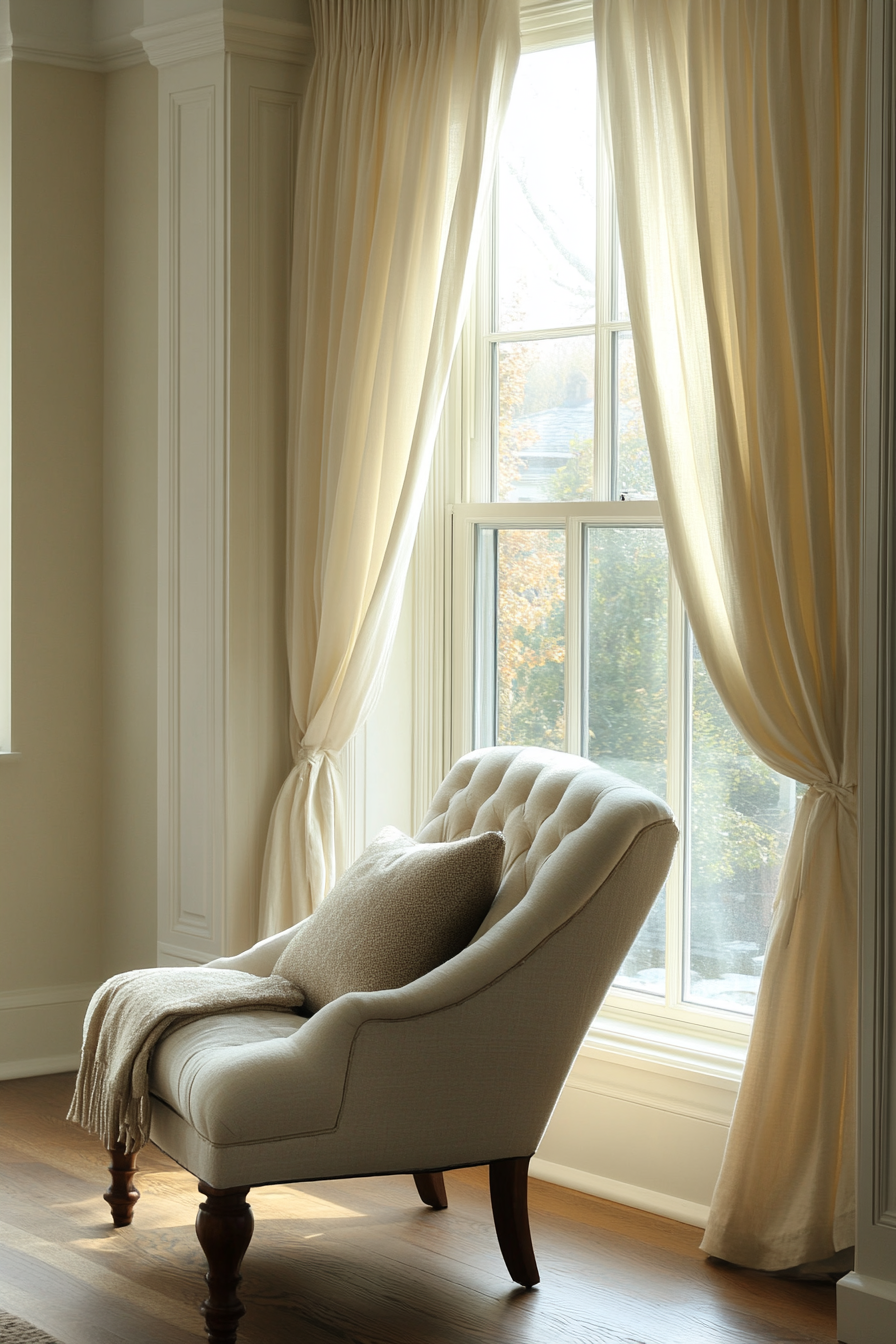
Flanking a window with curtain panels amplifies its presence.
The extra fabric on each side widens the window optically.
For this technique, mount the rod wider than the window itself, just like we discussed earlier.
Then use two separate curtain panels spaced apart to flank the window.
Or buy a pre-made pair of lined up panels.
Make sure the two panels are equal widths to nicely frame the window.
Widths that differ look unbalanced.
Measure carefully so the panels hang symmetrically.
I recommend wider panels that puddle on the floor a bit for fullness.
Pooled curtains add elegance while exaggerating window height.
Just avoid excessive bunching.
This trick adds beautiful dimension versus just having one curtain panel.
The window pops visually while still letting light filter in between the fabric.
It becomes the true focal point.
Flanking works especially well on wide picture windows.
The paired panels emphasize the generous width.
Or do it on a narrow window to make it look double in size!
When decorating a space, don’t forget the power of flanks.
Drawing the eye with perfectly spaced curtains gives windows an upgrade.
Your windows will thank you for the royal treatment!
Use Layered Curtains
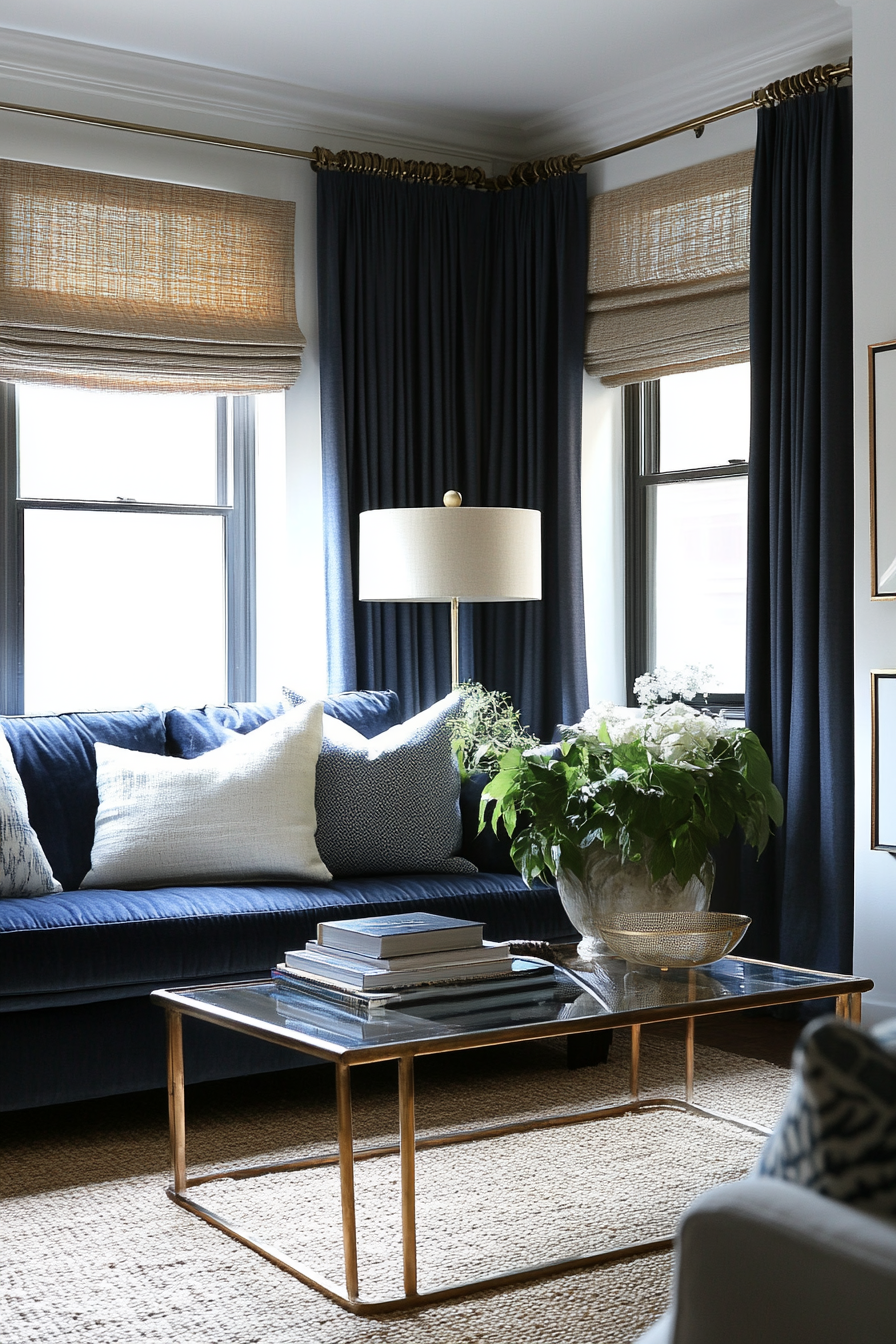
Another way to amplify windows is by layering two curtain treatments.
Layering adds textural interest while also exaggerating window height and width.
A common layering technique is pairing sheers behind opaque curtains.
The sheer peeks out when the solid curtains are open.
This gives a soft filtrating effect along with privacy when closed.
Or layer two opaque fabrics, like breezy linen curtains behind structured drapes.
Make one set full-length and the other a sill length.
Open and close them separately to alter the look.
When layering, use curtain rods close together so the panels overlap neatly.
Have the back rod hang higher to peek above the front.
Extend both rods wider than the window for extra width.
You can also layer curtains and blinds in the same window for multifunctional practicality.
Put blinds inside the window frame, then add a cosmetic outer rod for curtains.
This lets you control light and privacy easily.
Experiment with different layering combinations – the possibilities are endless!
Layering is a quick route to making windows look grandiose and custom.
Your windows will love the royal treatment.
Use Curtains to Soften Corners
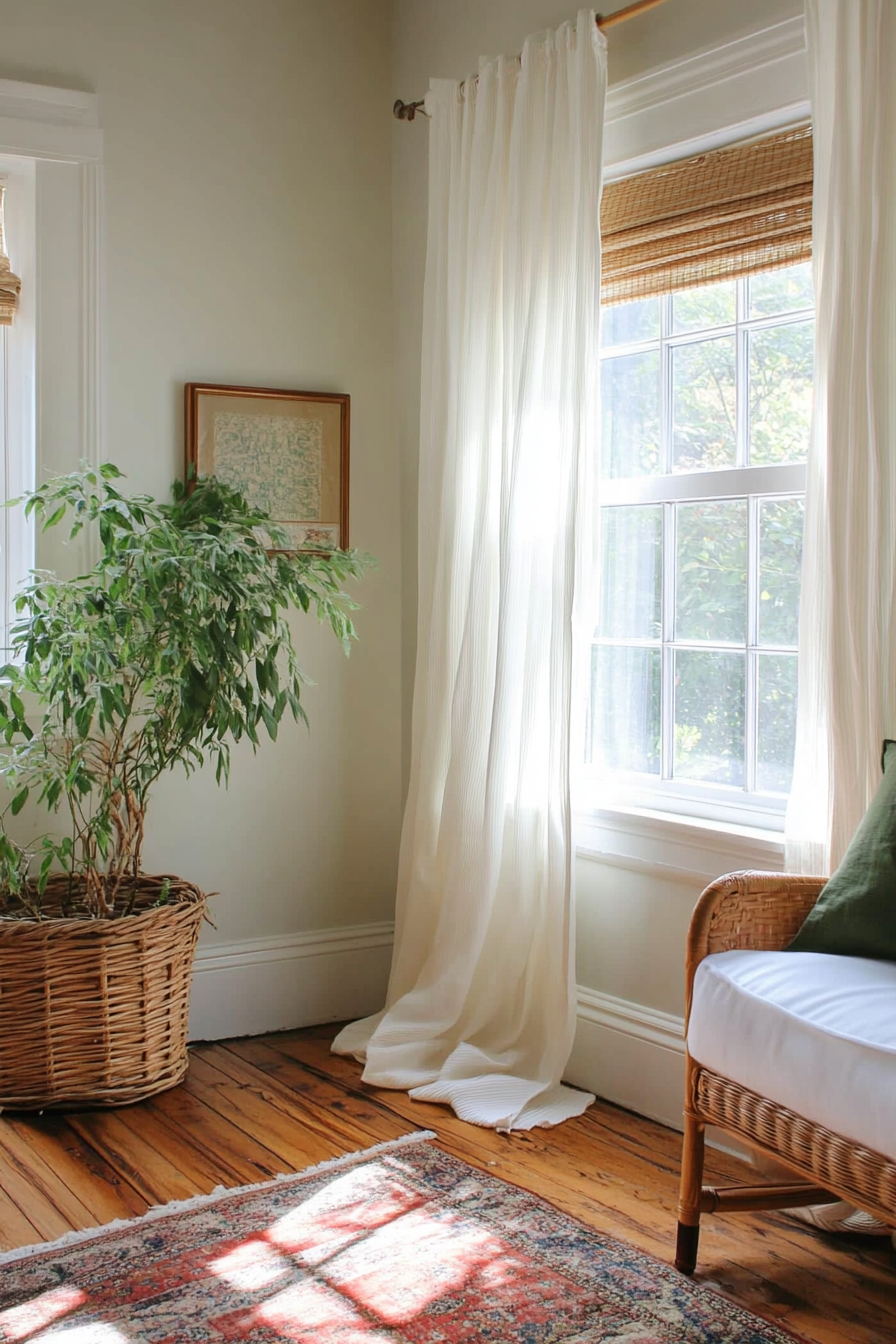
Installing a curtain that covers the corner of a room can help make the space feel more fluid and expansive.
The soft draped fabric diminishes the hard corners visually.
To do this, mount a curtain rod along one wall, a foot or two out from the corner.
Hang a floor-length panel so it covers the wall corner when closed.
Choose a lightweight, breezy fabric like voile or linen so it billows gently.
Avoid stiff drapes that won’t move with the air.
You can keep the corner curtain open and flowing to soften the lines.
Or draw it closed for a cozier, chamber-like feel that opens up the rest of the room.
This works especially well in bedrooms and living spaces where you want a calming vibe.
The fabric masks harsh angles to smooth out the geometry.
Concealing wall corners minimizes their visual weight.
This expands the eyes outward, making the whole room feel more curved and organic.
So don’t overlook the power of corner curtains to refine boxy architecture.
A little draped fabric goes a long way to soften up your living space.
✨Click to Get My 101 FREE Designer Room Ideas
Add Curtain Tiebacks for Fullness
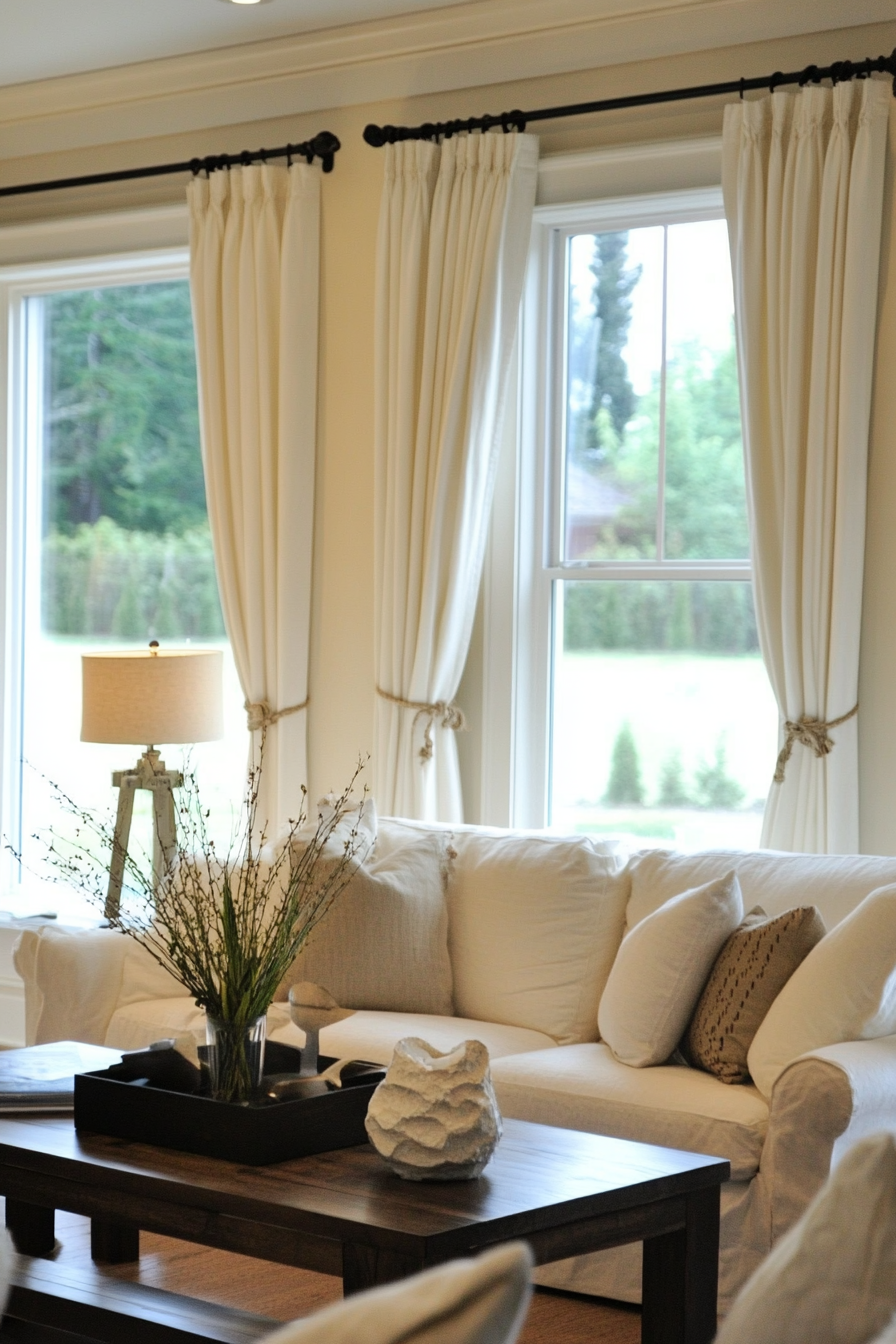
Tiebacks create instant curtain fullness for a luxurious look.
The gathered fabric adds body and accentuates window height.
For a super-easy upgrade, simply add clip-on tiebacks to existing curtains.
Clips attach in seconds to create a held-back style.
Hide the tieback clips behind the panels for a built-in look.
If your panels have back grommets, thread decorative rope through them to tie back instead.
Tassel trim adds a nice finishing touch.
Make sure the tiebacks anchor securely.
For a more striking statement, sew or glue permanent tiebacks to the back of each panel.
Fold the fabric into even pleats before securing.
Place the tiebacks a quarter to halfway up the panel to create a billowing effect below.
Avoid tying right at the top – this pulls the fabric too flat.
Allow generous gathering.
Beyond the fullness factor, tiebacks also show off more of your pretty window panels.
You get to admire the fabric design instead of just the front edges.
Tiebacks work with any style from breezy sheers to heavy drapes.
They give an upscale elegant vibe with minimal effort.
Instantly upgrade your windows with this easy add-on detail.
Install a Cornice Box Valance
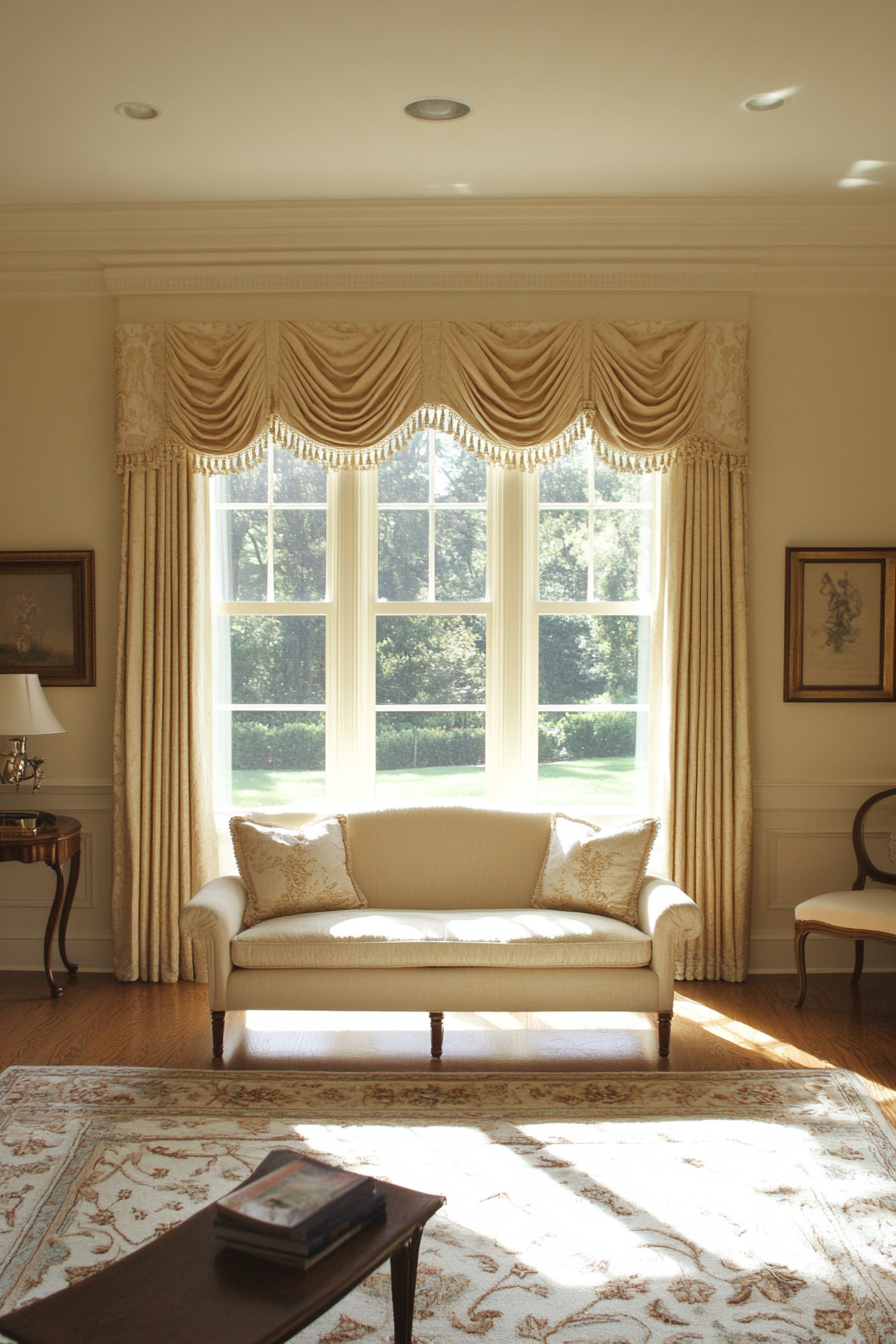
For a more advanced window treatment, install a decorative cornice box valance.
This built-in architectural feature crowns the window elegantly while creating the illusion of greater height.
A cornice box valance consists of a fabric-wrapped horizontal box mounted above the window.
The box structure provides a prominent base to dress the window.
The protruding shape makes the window pop.
Stretching the valance width wider than the window also expands the horizontal span, just like extending the curtain rod.
I usually make my valances 4-8 inches wider than the window frame.
When designing a cornice, pay attention to proportions.
Size the box depth and valance height to fit the scale of your window and room.
Avoid overwhelming the space.
For a lightweight fabric like silk, make a shallow box 1-3 inches deep.
For heavy drapes, go up to 6 inches deep.
Keep valance height fairly narrow to maintain a cohesive look.
Beyond the optical impacts, cornices also conceal curtain rods and hardware.
The box covers up any unsightly mechanics for a streamlined finish.
Installing a custom cornice box valance takes more work than just hanging curtains.
But it truly elevates a window into a showstopping focal point.
Your windows will thank you for the royal treatment!
Use Bright White Curtains to Maximize Light
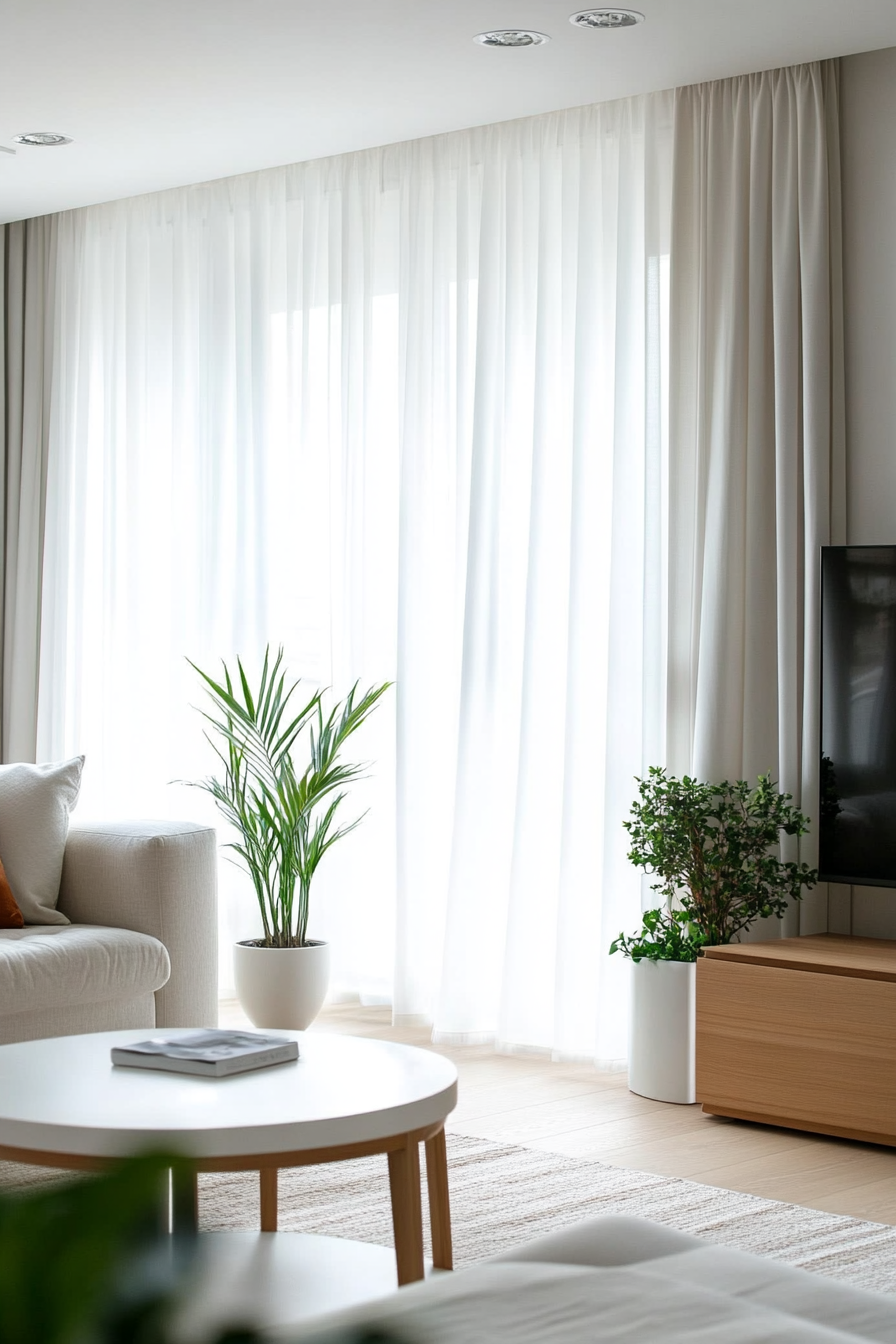
Strategically placing bright white curtains can make a room feel larger by maximizing natural light brightness.
The light bounces around, reaching even the corners.
White reflects the most visible light of any color.
It enhances luminosity far more than dark curtains that absorb light.
Just like wearing a black shirt on a hot day versus a white one!
Floor to ceiling white curtains create the illusion of tall, sunlit walls.
The light filtering through makes the room feel pleasant and airy.
I often recommend white for small rooms where clients want a fresh, clean look.
The bright ambiance makes dingy spaces feel bigger.
Just avoid going overboard into a sterile hospital vibe.
Balance with other homey elements.
Sheer white curtain panels work wonderfully to gently filter and amplify daylight.
Or try shimmery textured whites to add depth.
Ivory, cream and oyster also bring brightness if pure white feels harsh.
Along with increased light, white reflects to make spaces look larger.
Darker colors recede visually, shrinking a room’s dimensions.
White has the opposite effect – it bounces outward to expand the walls.
Just note that white shows dirt easily.
Wash panels frequently to maintain that pristine bright look.
Close them on rainy days so road grime doesn’t transfer through.
Keep them fresh!
Harnessing the power of white turns your windows into magical lightboxes.
Bring brightness and spaciousness in with strategic white curtains.
Use Curtains to Conceal Architectural Elements
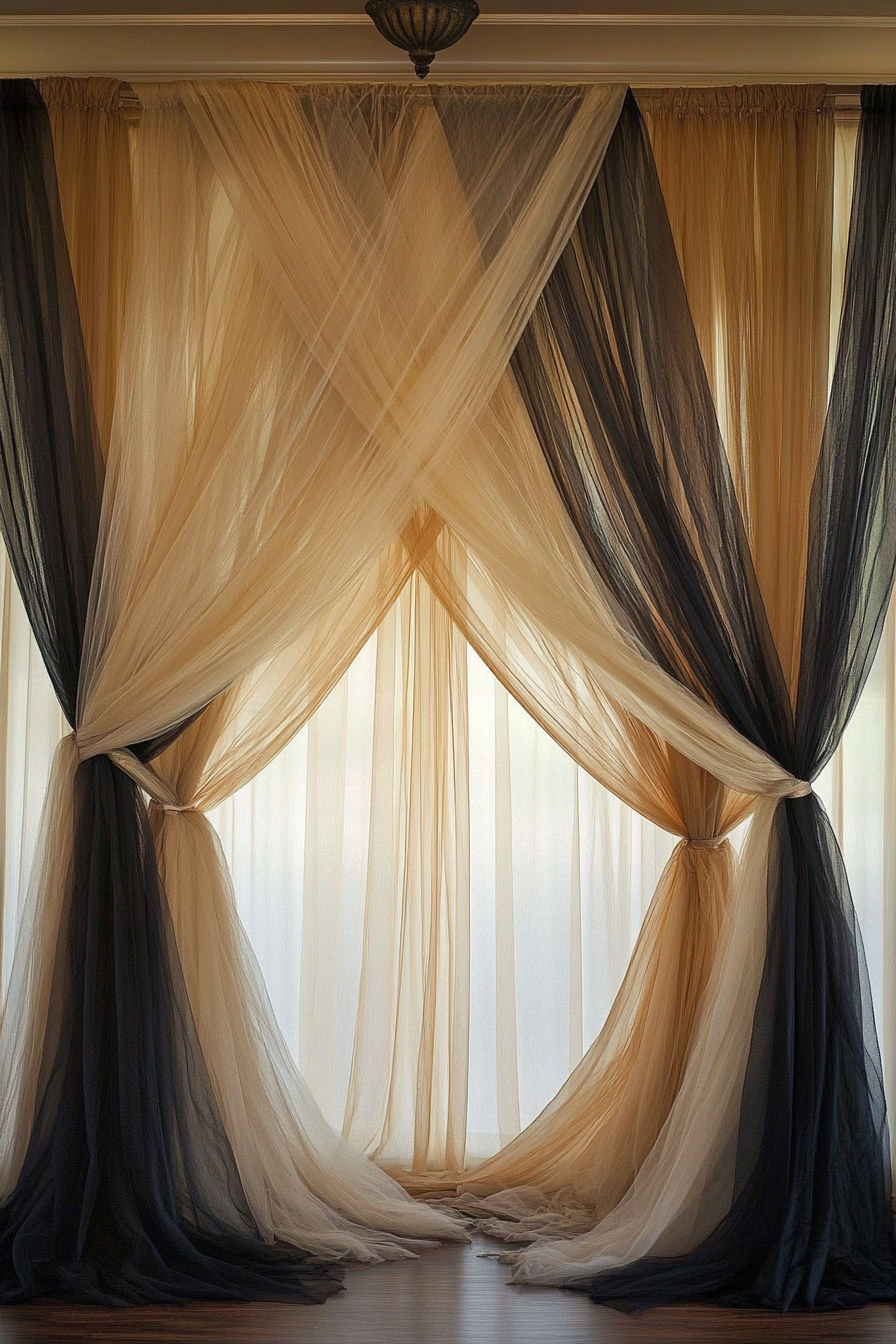

Hanging curtains directly over architectural elements like radiators, AC units or pipes can make them visually disappear.
This minimizes bulky features that cramp the room.
Measure the height and width of the element you want to conceal.
Cut curtain panels to those dimensions or larger to fully cover it.
Mount a slim rod just above the object.
Hang matching curtains that fully shroud the item when closed.
Keep them drawn to essentially erase it from the room.
This is perfect for disguising awkward radiators, exposed ductwork, fire sprinklers or cables.
The curtains disguise the unsightly objects so your eye doesn’t stop there.
Use neutral, blended curtain colors that match the walls to make the element vanish into the backdrop.
Avoid bold prints or colors that will attract attention.
You can also use concealment curtains between open kitchen shelves, covering the clutter.
Keep them open when cooking and drawn when guests are over.
With mindful concealing, curtains help streamline rooms by hiding bulky elements.
Minimize the distractions so the overall space can shine.
✨Click to Get My 101 FREE Designer Room Ideas
Hang Curtains Just Below the Ceiling
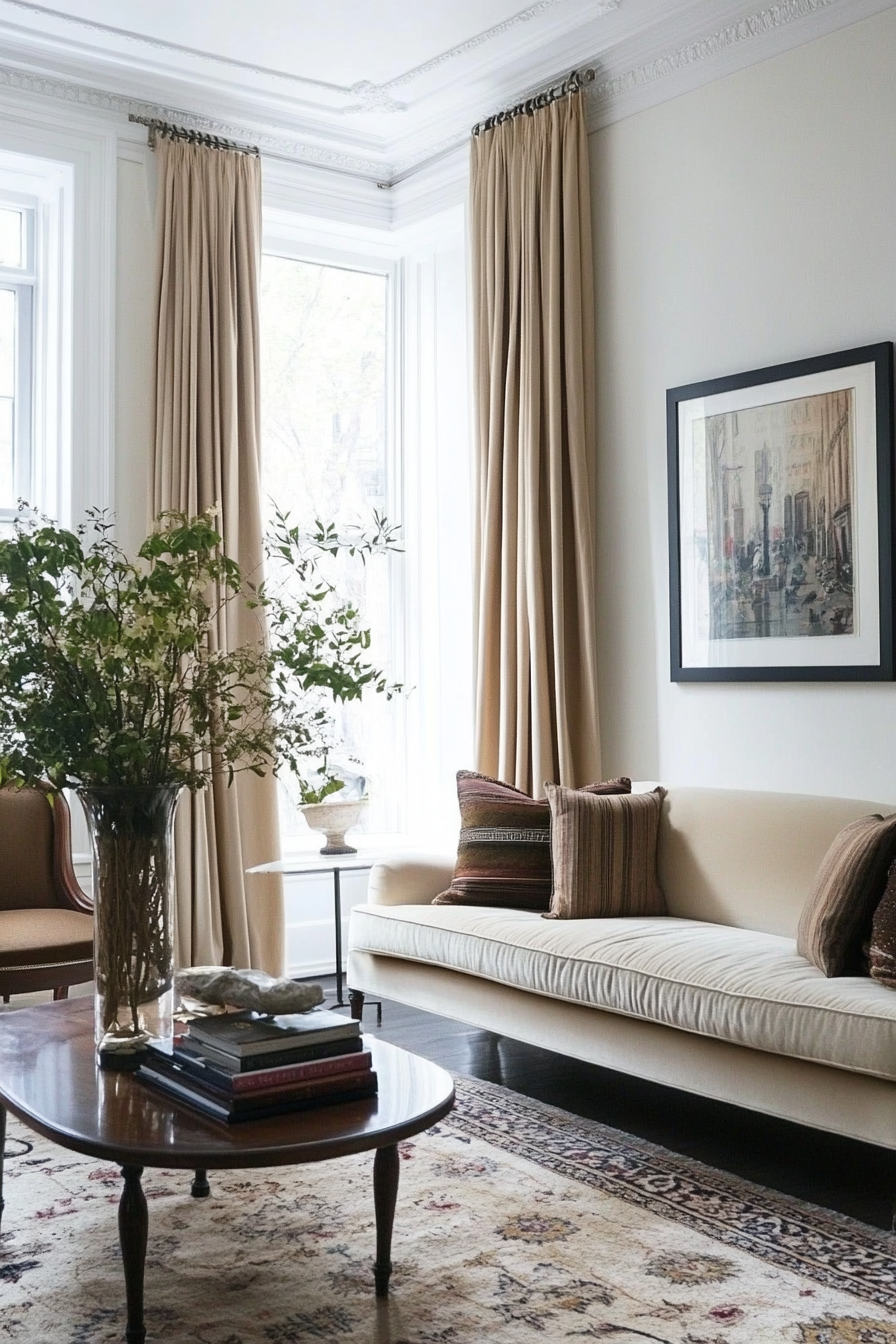
Here’s another way to enhance the illusion of higher ceilings: hang curtains as close to the ceiling as possible.
Aligning the tops of your curtains with the ceiling line extends the wall visually.
Measure carefully and use a level when mounting curtain rods.
Install them right where the wall meets the ceiling for seamless alignment.
Most pros recommend at least 3 inches below ceiling trim.
This ensures plenty of clearance.
The rod needs to be mounted sturdily for this near-ceiling look.
Use brackets anchored into studs, not flimsy wall anchors.
Test for level and stability so the rod doesn’t sag.
Drawing the eye upward with high-mounted curtains helps elevate a room visually.
Low rod heights can drag a space down, making it feel compressed.
Avoid mounting lower than about 6 inches above the window frame.
Any lower looks saggy.
For maximum vertical extension, combine ceiling-height curtains with the rod mounted 3 inches below trim.
This makes an ordinary 9-foot ceiling feel like 12 feet high!
It makes quite an impression.
Aligning curtains with the ceiling line keeps your eye moving upward, extending the perspective.
The room feels more lofty and open at the top.
With thoughtful styling, even low ceilings can get that soaring sensation!
The right curtains can turn the most modest room into a sanctuary.
With a little creativity, any home can feel open, peaceful and expansive.
I hope these tips sparked ideas to refresh your rooms.
Part of my job as a designer is revealing a room’s full potential.
Thoughtful styling makes a house shine.
I’m always excited to explore new window treatment ideas with clients.
Together we can create gorgeous, livable spaces.

